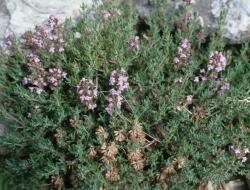- Taxon
- Weed
- Gallery
Small, hairy shrub to c. 30 cm high. Shoots dense, erect or suberect, densely clothed in short hairs. Lvs sessile or subsessile, 3–8 × 0.5–3 mm, elliptic but appearing linear because of revolute margins, densely hairy, with abundant oil globules, tomentose along midrib below. Fls in dense terminal heads; lower verticels often interrupted. Bracts similar to lvs, often somewhat wider, green, < to > calyx. Calyx 3–4 mm long, campanulate, green or purplish, hairy, dotted with oil globules, with tuft of white hairs in throat; teeth of upper lip ovate, not ciliate; teeth of lower lip linear-subulate, long-ciliate. Corolla 4–6 mm long, white or mauve; tube not exserted, hairy outside; upper lip with large, broad, oblong-elliptic to obovate lobes, sparsely hairy or glabrous; lower lip at right angles to upper. Stamens not or scarcely exserted; anthers purplish. Nutlets 6–8 mm diam., broad-ellipsoid to sub-spherical, dark brown.
[From: Webb et al. (1988) Flora of New Zealand. Volume 4.]
Flowering: Sep.–Dec.




